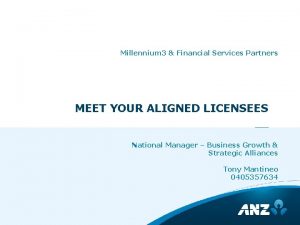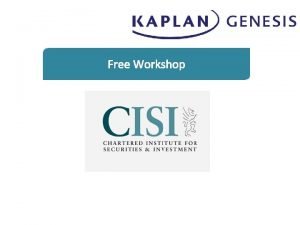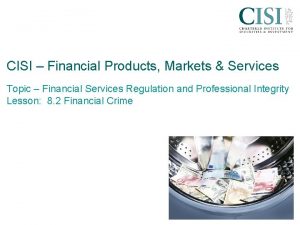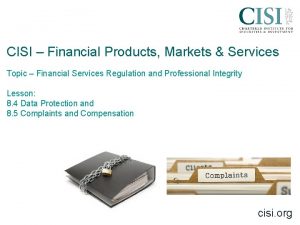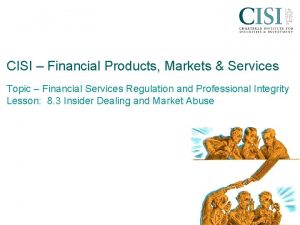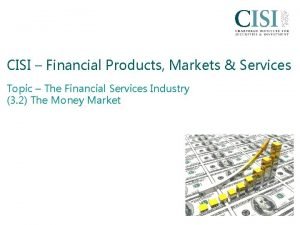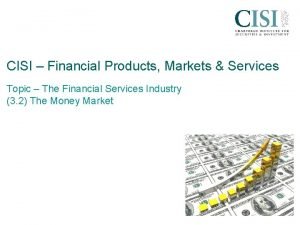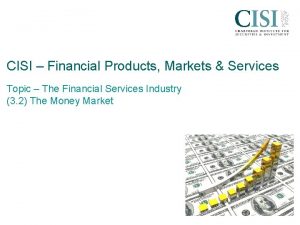CISI Financial Products Markets Services Topic Financial Services










- Slides: 10

CISI – Financial Products, Markets & Services Topic – Financial Services Regulation Lesson: 8. 1 Financial Services Regulation cisi. org

What are regulations? “Rules or directives made and maintained by an authority” “Regulation exists because of the potential economic and social effects of major financial instability, the desirability of maintaining markets which are efficient, orderly and fair and the need to protect retail consumers in their dealings with the financial services industry” Lord Turner of Ecchinswell, Chairman of the FSA in December 2005 cisi. org

Purpose of Regulations in Financial Services The financial services industry is all about money and investment – things can go wrong. Protection for the public against the risk of losing money due to sharp practice or poor decision-making has always been required The main purpose and aims of regulations in the industry: 1. Maintain and promote fairness, efficiency, competiveness, transparency and orderliness; 2. Promote understanding by the public of the operation and functioning of the financial services industry; 3. Provide protection for members of the public investing in, or holding financial products; 4. Minimise crime and misconduct in the industry; 5. Reduce systemic risks; and 6. Assist in maintaining the market’s financial stability by taking appropriate steps. cisi. org

Financial Services Regulations – How they developed 3. Development of global markets – International cooperation: § Series of crises e. g. collapse of Barings Bank, Enron, World. Com § 2008 Credit Crunch - a common approach needed § Co-operation between regulators worldwide e. g. Anti-money laundering rules or o p r o ctice a r p p har s o ion t t c e e u t d o ney d pr o e e m n g c bli osin u l p f o e h k t nd A ris a – s r g o n t wro nves I o g – n g a n c ki 2. Development of markets, financial Things ecision-ma d institutions and services – Regulatory bodies: § Greater impact on society and the economy § Self-regulation no longer worked § Countries took a statutory approach – rules were formalised. § Regulatory bodies were set up. e. g. FSA (Now FCA) 1. Initial market development – Self-regulation: § Participants began to set the rules § Agreed standards of behaviour set cisi. org e. g. Stock exchanges set rules for members and policed their implementation

Financial Services Regulations – Impact – The UK UK Regulation Financial Services and Markets Act 2000 (FSMA 2000) 01. 12. 2001 This piece of legislation simplified things from a previous mixture of different laws and different ways of enforcing them. The Financial Services Authority (FSA) was formed as a result of FSMA 2000 and was responsible for the regulation of the financial services industry. The Financial Crisis - 2008 saw the need to strengthen UK regulatory frameworks to deal with all firms and the global nature of markets. 1 st April 2013 - the Government made changes to the way the financial services industry is regulated. Financial Stability Financial Policy Committee (FPC) § Established in the Bank of England (Bo. E) § Responsible for macro-prudential regulation (Ensuring the overall UK financial system remains stable) Promoting safety and soundness Prudential Regulation Authority (PRA) § Regulates and supervises ‘significant’ individual firms. § Includes deposit-taking institutions, insurers and other prudentially significant investment firms. § Main objective – enhance financial stability by promoting the safety and soundness of PRA-authorised firms. Retail and wholesale cisi. org Financial Conduct Authority (FCA)

Financial Conduct Authority (FCA) Established in 2013, along with the PRA and FPC, replacing the FSA. HM Treasury is responsible for oversight of how the FCA conducts its operations. It is accountable to Treasury Ministers and Parliament. Role of the FCA § Supervises investment exchanges § Monitors firms’ compliance with the Market Abuse Directive (MAD) § Investigate and prosecute insider dealing § Oversees the Financial Ombudsman Service (FOS), Money Advice Service (MAS) and the Financial Services Compensation Scheme (FSCS) Responsibilities under the Financial Services Act 2012 § Regulates standards of conduct in retail and wholesale markets (Around 26, 000 firms). § Supervises trading infrastructures that support these markets. § Prudential supervision of firms that are not PRA-regulated. § The functions of the UK Listing Authority (UKLA). 3 Statutory Objectives § Protect consumers § Enhance integrity of the UK financial system § Maintain competitive markets and Promote effective competition in the interest of consumers. cisi. org

FCA - Authorisation The Financial Services and Markets Act makes it an offence for a firm to provide financial services in the UK without authorisation from the FCA. Some firms are dual-regulated – regulated by the FCA for they conduct business and by the PRA for prudential requirements. How does the authorise firms? They look at each applicant firm and determine whether they are ‘fit and proper’ to provide financial services Does the firm meet certain threshold conditions? Quality of the company’s management? How financially strong is the company? Calibre of its staff? cisi. org

FCA – Approved Persons People who work in key roles in a firm (Controlled functions) must be approved by the FCA to carry out their job. For those working in a controlled function, the FCA will assess a person via The Fit and Proper Test for Approved Persons. If a person passes, they will be granted approved person status. The FCA look at a number of factors against three main criteria: Honesty, integrity and reputation § Any criminal records? § Any history of regulatory misconduct? Competence and capability to fulfil the role § Passed certain regulatory exams? Financial soundness § What is their financial situation? § What is their financial history cisi. org

FCA - Controlled Functions are: § Those involved in dealing with customers or their investments § Key managers in a firm (Includes, finance, compliance and risk § Those exercising a measure of control over the firm as a whole They are classified into 3 groups: Significant Influence Functions Governing Functions e. g. Directors of the firm Significant Management Functions e. g. Senior Managers Systems and Control Functions e. g. Responsible for risk management and internal audit Required Functions e. g. Specific roles – Snr Mgr responsible for compliance oversight Customer Functions Those managing investments or providing advice to customers. These are not significant influence functions Setting Benchmarks Those involved in setting benchmarks like the London Interbank Offered Rate (LIBOR) cisi. org

Treating Customers Fairly (TCF) Want to achieve their statutory objective of protecting the consumer Since the financial crisis, conduct risk (How a firm treats customers and investors and how they behave) is high on the agenda for the FCA This approach challenges senior management of firms to work out how to treat customers fairly rather than dictate how they should. The FCA will look for evidence that firms have incorporated TCF throughout their operations and processes (systems, controls and culture) as well as having the right data and information available. 6 TCF Outcomes Consumers can be confident that they are dealing with firms where the fair treatment of customers is central to the corporate culture. Products and services marketed and sold in the retail market are designed to meet the needs of identified consumer groups and are targeted accordingly. Consumers are provided with clear information and are kept appropriately informed before, during and after the point of sale. Where consumers receive advice, the advice is suitable and takes account of their circumstances Consumers are provided with products that perform as firms have led them to expect, and the associated service is of an acceptable standard and as they have been led to expect. Consumers do not face unreasonable post-sale barriers imposed by firms to change product, switch provider, submit a claim or make a complaint. cisi. org
 Chartered wealth manager cisi
Chartered wealth manager cisi Chartered wealth manager cisi
Chartered wealth manager cisi Cisi wealth management
Cisi wealth management Cisi wallin
Cisi wallin Cisi introduction to securities and investment
Cisi introduction to securities and investment Cisi or cfa
Cisi or cfa Creating products for consumers in global markets
Creating products for consumers in global markets Clincher sentence example
Clincher sentence example Tapic about internet
Tapic about internet Functional and innovative products supply chain
Functional and innovative products supply chain Marketing mix of pepsi and coca cola
Marketing mix of pepsi and coca cola



